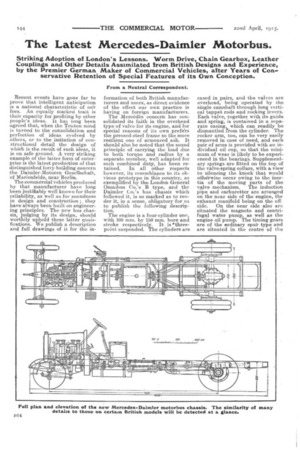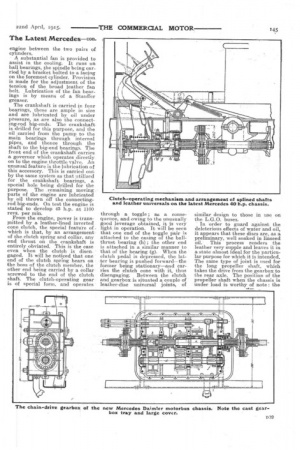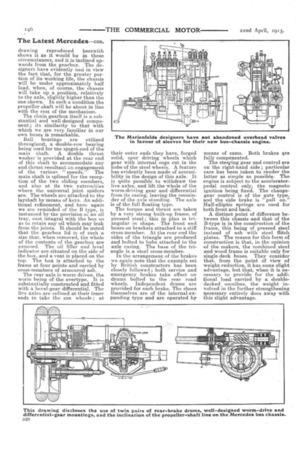The Latest Mercedes-Daimler Motorbus.
Page 4

Page 5

Page 6

Page 7

If you've noticed an error in this article please click here to report it so we can fix it.
Striking Adoption of London's Lessons. Worm Drive, Chain Gearbox, Leather Couplings and Other Details Assimilated from British Designs and Experience, by the Premier German Maker of Commercial Vehicles, after Years of Conservative Retention of Special Features of its Own Conception.
From a Neutral Correspondent.
Recent events have gone far to prove that intelligent anticipation is a national characteristic of our foes. An equally marked trait is their capacity for profiting by other people's ideas. it has long been agreed that, when the Teuton mind is turned to the consolidation and perfection of. ideas evolved by others, or to the imitation of constructional detail the design of which is the result of such ideas, it is on safe ground. A very striking example of the latter form of enter-. prise is the latest production of that distinguished lorry-building concern the Daimler-Motoren Gesellschaft, of Marienfelde, near Berlin.
The commercial vehicles produced by that manufacturer have long been justifiably well known for their reliability, as well as for soundness in design and construction ; they have always been built on engineering principles. The new bus chassis, judging by its design, should worthily uphold these latter quailfieations. We publish a description and full drawings of it for the in
formation of both British manufacturers and users, as direct evidence of the effect our own practice is having on foreign manufacturers.
The Mercedes concern has consolidated its faith in the overhead type of valve for its engine, and for special reasons of its own prefers the pressed-steel frame to the more resilient one of ai-moured ash. It should also be noted that the sound principle of carrying the load due to both torque and radius by a separate member, well adapted for such combined duty, has been retained. In all other respects however, its resemblance to its obvious prototype in this country, as exemplified by the London General Omnibus Co.'s B type, and the Daimler Co.'s bus chassis which followed it, is so marked as to render it, in a sense, obligatory for us to publish the following description.
The engine is a four-cylinder one, with 108 mm. by 150 mm. bore and stroke respectively. It is 'threepoint suspended. The cylinders are
cased in pairs, and the valves are overhead, being operated by the single camshaft through long vertical tappet rods and rocking levers. Each valve, together with its guide and spring, is contained in a separate casing, which can readily be dismantled Nom the cylinder. The rocker arm, too, can be very easily removed in case of need, arid each pair of arms is provided with an Individual oil cup, so that the minimum of wear is likely to be experienced in the bearings. Supplementary springs are fitted on the top of the valve-spring collars, with a view to silencing the knock that would otherwise occur owing to the inertia of the moving parts of the valve mechanism. The induction pipe and earburetter are arranged on the near side of the engine, the exhaust manifold being on the off side. On the near side also are situated the magneto and centrifugal water pump, as well as the engine oil pump. The timing gears are of the ordinary spui• type and are situated in the centre of the
engine between the two pairs of cylinders.
• A substantial fan is provided to assist in the cooling. It. runs on ball bearings, the spindle being carried by a bracket bolted to a lacing an the foremost cylinder. Provision is made for the adjustment of the tension of the broad leather fan belt, Lubrication of the fan bearings is by means of a Stauffer greaser.
The crankshaft is carried in four bearings, these are ample in size and are lubricated by oil under pressure, as are also the connecting-rod big-ends. The crankshaft is arilled for this purpose, and the oil carried from the pump to the main bearings through internal pipes, and thence through the shaft to the big-end bearings. The front end of the crankshaft carries a, governor which operates directly on te• the engine throttle valve. An unusual feature is the lubrication of this accessory. This is carried out by the same system as that utilized for the crankshaft bearings, a special hole being drilled for the purpose. The remaining moving parts of the engine are lubricated by oil thrown off the connectingrod big-ends. On test the engine is stated to develop 43 h.p. at 1100 revs, per min.
From the engine, power is transmitted by a leather-lined inverted cone clutch, the special feature of. which is that, by an arrangement of the clutch spring and collar. any end thrust on the crankshaft is entirely obviated. This is the case even when the clutch is disengaged. It will be noticed that one end of the clutch spring bears on the boss of the clutch member, the other end being carried by a collar screwed to the end of the clutch shaft. The clutch-operating gear is of special form, and operates
through a toggle ; ae a consequence, and owing to the unusually good leverage obtained, it is very light in operation. It will be seen that one end of the toggle pair is attached to the casing of the ballthrust bearing (h) ; the other end is attached in a similar manner to that of the bearing (g). When the clutch pedal is depressed, the latter bearing is pushed forward—the former being stationary—and carries the clutch cone with it, thus disengaging. Between the clutch and gearbox is situated a couple of leather-disc universal joints, of
similar design to those in use on the L.G.O. buses.
In order to guard against the deleterious effects of water and oil, it appears that these discs are, as a preliminary, well soaked in linseed oil. This process renders the leather very supple and leaves it in a state almost ideal for the particular purpose for which it is intended. The same type of joint is used for the long propeller shaft, which takes the drive from the gearbox to the rear axle. The position of the propeller shaft when the chassis is under load is worthy of note : the drawing reproduced herewith shows it as it would he in these circumstances, and it is inclined upwards from the gearbox. The designers have evidently had in view the fact that, for the greater portion of its working life, the chassis will be under approximately half load, when, of course, the chassis will take up a position, relatively to the axle, slightly higher than the one shown. In such a condition the propeller shaft will be about in line with the rest of the mechanism.
The chain gearbox itself is a substantial and well-designed component; its similarity to that with which we are very familiar in our own buses is remarkable.
Ball bearings are utilized throughout, a ,double-row bearing being used for the spigot-end of the main shaft. A double thrust washer is provided at the rear end of this shaft to accommodate any end thrust resultant on engagement
of the variouc speeds." The main shaft is splined for the reception of the two sliding members, and also at its two extremities where the universal joint spiders are. The wheels are attached to the layshaft by means of keys. An additional refinement, and here again we are reminded of the B type, is instanced by the provision o; an oil tray, cast integral with the box so as to retain any oil which may leak from the joints. It should be noted that the gearbox lid is of such a size that, when removed, the whole of the contents of the gearbox are exposed. The oil filler and level indicator are situated on the side of the box, and a vent is placed on the top, The box is attached to the frame at four points and carried by cross-members of armoured ash.
The rear axle is worm driven, the worm being of the overtype. It is substantially constructed and fitted with a bevel-gear differential. The live axles are sunned at their inner ends to take the sun wheels ; at
their outer ends they have, forged solid, spur driving wheels which gear with internal cogs cut in the hubs of the steel wheels. A feature has evidently been made of accessibility in the design of this axle. It is quite possible to withdraw the live axles, and lift the whole of the worm-driving gear and differential from its casing, leaving the remainder of the axle standing. The axle is of the full floating type.
The torque and thrust are taken by a very strong built-up frame, of pressed steel; this in plan is triangular in shape. The front end boars on brackets attached to a stiff cross-member. At the rear end the sides of the triangle are produced and bolted to hubs attached to the axle casing. The base of the triangle is a steel cross-member.
In the arrangement of the brakes we again note that the example set by British constructors has been closely followed ; both service and emergency brakes take effect on drums bolted to the rear road wheels. Independent drums are provided for each brake. The shoes themselves are -of the internal-expanding type and are operated by means of cams. Both brakes are fully compensated.
The steving gear and control are on the right-hand side ; particular care has been taken to render the latter as simple as possible. The engine is subject to the acceleratorpedal control only, the magneto ignition being fixed. The changegear control is of the gate type, and the ride brake is "pull on." Half-elliptic springs are used for both front and back.
A distinct point of difference between this chassis and that of the B-type is in the construction of the frame, this being of pressed steel instead of ash with steel flitch plates. The reason for this form of -construction is that, in the opinion of the makers, the combined steel and wood frame is suitable only for single-deck buses. They 'consider that, from the point of view of weight reduction, it has some slight advantage, but that, when it is necessary to provide for the additional load carried by a doubledecked omnibus, the weight involved in the further strengthening necessary entirely does away with this slight advantage.
Toronto Matter.
Our Toronto cor re spondent writes :—" Since I sent you a photograph of the latest White motor fire-engine: which was recently added to the equipment of the Toronto Fire Brigade, three more machines have been delivered to that establishment—two . American La France and one Seagrave. FireChief Thompson, after 40 years service with the city, has just resigned. He has done much for motors.
" The annual motor show, held recently in Montreal, was a great success. notwithstanding the adverse influences of the war. A total of 230 machines was exhibited, and the novelties included armoured cars and a war biplane."
Road Board Grants.
The list of grants by the Road Board, for the three months ended the 31st March last, amounts to the small total of £80,143. This is due to the change of policy which the Board has had to adopt by reason
of war effects. Local authorities have not the labour nor the material available for any extensive road-making or reconstruction schemes, and practically the whole of the energies of the Road Board are absorbed in connection with military roads through new camps. Much labour has been transferred from various county and borough authorities, to the control of the Board, for the purpose, under the direction of its general manager, Mr. H. P. Maybury, M.Inst.C.E.




















